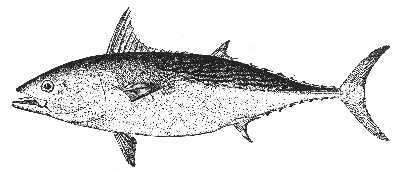False albacore Euthynnus alleteratus (Rafinesque) 1810
LITTLE TUNNY; BONITO
[Jordan and Evermann, 1896-1900, p. 258.]

Figure 179.—False albacore (Euthynnus alleteratus), Woods Hole. From Jordan and Evermann. Drawing by H. L. Todd.
Description—
This bonito resembles the striped bonito (p. 335) very closely in body form, in size and arrangement of its fins, and in the fact that its body has no scales except on the forward and upper part of the trunk, the corselet, and along the lateral line. But it is distinguishable from the striped bonito by its color pattern, for it is above its lateral line that its sides bear dark markings, not below. And its lateral line does not bend downward appreciably below the second dorsal fin.[80] Also, its anal fin originates relatively farther back than in the striped bonito, i. e., under the first dorsal finlet instead of under the middle of the second dorsal fin.
[page 337]Color—
Steel blue above, glistening white lower down on the sides and on the belly. The sides are without markings below the lateral line, except for a few dark spots below the pectoral fin, but are marked above the lateral line with dark wavy bands, in various patterns.
Size—
About the same as E. pelamis, i. e. growing to about 2½ feet.
General range—
This, like its relative pelamis is a tropical-oceanic fish, widespread on the high seas, in all the great oceans.
Occurrence in the Gulf of Maine—
False albacores are picked up from time to time near Woods Hole, in July or August. But the only records of them within our Gulf are of 200 to 300 taken in a trap at Barnstable, in the autumn of 1948,[81] and of 28 taken in another trap in Cape Cod Bay, near Sandwich, on September 11, 1949.[82] Like various other tropical fishes they come our way only as strays from warmer seas; they are likely to be in schools whenever they reach our Gulf.
[80] For further differences between the species of Euthynnus, see Fraser Brunner, Ann. Mag. Nat. Hist., Ser. 12, vol. 3, 1950, p. 150.
[81] Reported to us by Frank Mather of the Woods Hole Oceangraphic Institution. All of these, weighing 2,498 pounds, were caught on September 16 in the trap of John Vetorino.
[82] Schuck, Copeia, 1951, p. 98.